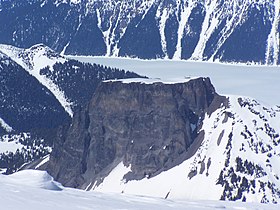The Table
| The Table | |
|---|---|

The Table rises above the southwest side of Garibaldi Lake
|
|
| Highest point | |
| Elevation | 2,021 m (6,631 ft) |
| Prominence | 251 m (823 ft) |
| Coordinates | 49°53′43″N 123°00′47″W / 49.89528°N 123.01306°WCoordinates: 49°53′43″N 123°00′47″W / 49.89528°N 123.01306°W |
| Geography | |
| Location | British Columbia, Canada |
| Parent range | Garibaldi Ranges |
| Topo map | NTC 92G/14 Cheakamus River |
| Geology | |
| Age of rock | Holocene |
| Mountain type | Tuya |
| Volcanic arc/belt | Canadian Cascade Arc Garibaldi Volcanic Belt |
| Last eruption | Holocene |
| Climbing | |
| First ascent | 1916 Tom Fyles |
The Table, sometimes called Table Mountain, is a 2,021-metre (6,631 ft) high flow-dominated andesite tuya located 4 kilometres (2 mi) south of Garibaldi Lake, 15 kilometres (9 mi) northeast of Cheekye and 5 kilometres (3 mi) north of Mount Garibaldi, British Columbia, Canada. It rises over 530 metres (1,740 ft) above the surface of Garibaldi Lake, which lies less than 1 kilometre (1 mi) to the north.
The Table is almost impossible to climb because sections of the volcano have collapsed, creating steep and exceptionally rotten rock walls on all sides.
The Table is part of the Garibaldi Lake volcanic field, a volcanic field that includes a group of nine small andesitic stratovolcanoes and basaltic andesite vents formed during the early Holocene. This in turn is part of the Garibaldi Volcanic Belt and of the Cascade Volcanic Arc that run from southwestern British Columbia to northern California caused by subduction of the Juan de Fuca Plate and Explorer Plate under the North American Plate at the Cascadia subduction zone.
Canadian geologist Bill Mathews proposed in 1951 that The Table formed when magma intruded into and melted a vertical tube in the overlying Cordilleran Ice Sheet. The partially molten mass of hornblende-phyric andesite cooled as a large block, with gravity flattening its upper surface. Horizontal columns occur at numerous locations along the periphery of the mass. The absence of glacial erosion of the tuya suggests that it erupted during the early Holocene, just prior to the disappearance of the ice sheet. Similar formations can be found in the Wells Gray-Clearwater volcanic field, the Northern Cordilleran Volcanic Province and elsewhere in the Garibaldi Volcanic Belt.
...
Wikipedia
